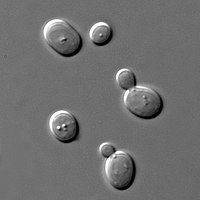
Photo from wikipedia
Diastatic strains of Saccharomyces cerevisiae possess the unique ability to hydrolyze and ferment long-chain oligosaccharides like dextrin and starch. They have long been regarded as important spoilage microbes in beer,… Click to show full abstract
Diastatic strains of Saccharomyces cerevisiae possess the unique ability to hydrolyze and ferment long-chain oligosaccharides like dextrin and starch. They have long been regarded as important spoilage microbes in beer, but recent studies have inspired a re-evaluation of the significance of the group. Rather than being merely wild-yeast contaminants, they are highly specialized, domesticated yeasts belonging to a major brewing yeast lineage. In fact, many diastatic strains have unknowingly been used as production strains for decades. These yeasts are used in the production of traditional beer styles, like saison, but also show potential for creation of new beers with novel chemical and physical properties. Herein, we review results of the most recent studies and provide a detailed account of the structure, regulation, and functional role of the glucoamylase-encoding STA1 gene in relation to brewing and other fermentation industries. The state of the art in detecting diastatic yeast in the brewery is also summarized. In summary, these latest results highlight that having diastatic S. cerevisiae in your brewery is not necessarily a bad thing. •Diastatic S. cerevisiae strains are important spoilage microbes in brewery fermentations. •These strains belong to the ‘Beer 2’ or ‘Mosaic beer’ brewing yeast lineage. •Diastatic strains have unknowingly been used as production strains in breweries. •The STA1-encoded glucoamylase enables efficient maltotriose use.
Journal Title: Applied Microbiology and Biotechnology
Year Published: 2020
Link to full text (if available)
Share on Social Media: Sign Up to like & get
recommendations!